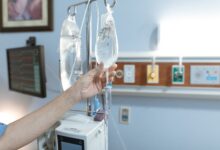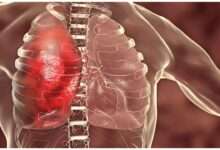
Angina pectoris, also called angina , is a heart disease causing chest pain. These pains appear when the heart is poorly oxygenated due to the narrowing of a coronary artery (which brings oxygenated blood to the heart).
The onset of angina pectoris can be related to stress or physical exertion . But it can also, more rarely, occur at rest.
The pains caused by angina pectoris are of the squeezing type (sensation that the chest is caught in a vice , this is called constrictive pain), suffocation or burning. These pains, which may be accompanied by palpitations or difficulty breathing, usually fade within minutes when the sufferers lie down or rest. Certain medications (trinitrine) can help alleviate them.
The pains are above all a warning : the heart signals that it is poorly oxygenated and that it is in pain. Angina pectoris is ultimately a warning sign of a more serious heart problem to come, especially a heart attack (MI or myocardial infarction).
In the presence of angina pectoris, the risk of a heart attack, for example, is higher. Angina pectoris can ultimately be the first stage of coronary disease.
It is therefore necessary, as soon as the first symptoms appear, to immediately rest and quickly consult a general practitioner, then a cardiologist for a complete medical check-up. The latter will confirm the diagnosis of angina through various medical examinations, find its causes and propose treatment if necessary.
Angina should not be ignored. The onset of pain must be explained, the warning signs known. Managing, monitoring and treating angina helps prevent other more serious heart conditions. In addition, if the pain lasts or is of significant intensity, it is imperative to contact the SAMU (15 or 112). The person may indeed suffer not from angina pectoris but from a myocardial infarction.
Prevalence
Angina pectoris is a very common disease . It concerns more than 10% of people over 65 in France.
Different types of angina
There are different types of angina, some with pain that passes quickly, others with sudden onset, unrelated to stress or physical activity. Thus, in the so-called stable angina pectoris , the pains remain the same over time. Their intensity is about the same and the triggering factors are known (climbing stairs for example). This type of angina, which can be triggered by stress or cold temperatures, is usually caused by chronic coronary insufficiency.
Conversely, in the case of unstable angina , the pain appears suddenly, without warning signs. The pain that occurs is of varying intensity. This type of angina is caused by acute coronary insufficiency and is relieved neither by rest nor by the drugs usually taken (when treatment has already been put in place).
In some cases, stable angina can worsen and become unstable. The pains become more frequent, strong and appear during less physical effort, for example. Or the pain responds less well to drug treatment. People affected by this change go from stress angina to resting angina and then, sometimes, to myocardial infarction.
Diagnostic
To confirm angina, the doctor, after having listed the risk factors of the person followed, may prescribe an electrocardiogram and blood tests. He will seek to explain the origin of the pain. For this, an echocardiography and a stress test may prove necessary, before possibly performing an x-ray of the arteries of the heart (coronarography).
Complications
The pain caused by angina pectoris can interfere with certain daily activities and require rest. But the most serious complication is of course heart attack or myocardial infarction , with a risk of sudden death. In this case, the artery of the heart, the coronary artery is no longer just narrowed as in angina pectoris, it is blocked entirely. And this risk must be taken into account. Hence the need for medical monitoring as soon as the first pains appear.
Causes
Angina pectoris is due to poor oxygenation of the heart muscle, itself more often due to a narrowing of the blood vessels. This narrowing in the coronary arteries is caused by atherosclerosis . Atheroma plaques (composed mainly of fat) gradually form on the wall of the vessels and gradually prevent the blood from circulating properly.
Other heart conditions such as heart valve damage or cardiomyopathy can also cause angina.
| Prinzmetal’s angina.It is a particular angina pectoris which is very rare. Indeed, angina attacks occur here outside of an effort . They are not linked to a plaque of atheroma narrowing the caliber of one of the arteries of the heart, but to a spasm of one of these arteries. This spasm slows the arrival of blood in the heart muscle which, suffering from this lack of oxygen, produces symptoms identical to classic angina (pains of the same type). The pains generally occur at regular times and recur cyclically . Two schedules are typical: the second part of the night or the period following a meal. The pain can lead to fainting. |
These signs generally occur on coronary arteries that also have atheroma. Prinzmetal’s angina must be treated quickly because it exposes to a high risk of infarction.
Symptoms associated with angina pectoris are:
- tightness-like chest pains
- burning sensation, cramps
- pain in the arm, neck, jaw, shoulder, back…
- nausea, vomiting
- feeling of indigestion
- fatigue
- shortness of breath
- anxieties
- sweat
- dizziness
If the symptoms evolve, it is imperative to consult a doctor quickly.
Angina Symptoms
Symptoms associated with angina pectoris are:
- tightness-like chest pains
- burning sensation, cramps
- pain in the arm, neck, jaw, shoulder, back…
- nausea, vomiting
- feeling of indigestion
- fatigue
- shortness of breath
- anxieties
- sweat
- dizziness
If the symptoms evolve, it is imperative to consult a doctor quickly.
People at risk and risk factors
There are 5 major risk factors:
– Smoking,
– Diabetes,
– High blood pressure,
– Dyslipidemia (especially high cholesterol),
– Coronary heredity: people at risk are men from 55 years old and women from 65 years old,
– Those who have a family member who has suffered or is suffering from a cardiovascular disease.
Prevention of angina pectoris
Preventing angina pectoris involves reducing the risk factors for this disease. It is therefore recommended not to smoke, to eat a balanced diet, not to be overweight or obese and therefore to lose weight if necessary, to control diabetes as best as possible for people who suffer from it, and to practice physical activity. regular.
Medical treatments for angina
Treatment of angina pectoris attack
To reduce the pain caused by angina pectoris, the doctor can prescribe trinitrine, in spray or sublingually (to be allowed to dissolve under the tongue) to be taken when the attack occurs. The person undergoing an attack of angina must stop all exertion and take the medication that has been prescribed. In general, the effect of trinitrin is very rapid. When you suffer from angina pectoris, it is necessary to keep this medicine on you, in order to use it quickly when needed.
Basic treatment for angina pectoris
This aims to slow down the aggravation of angina pectoris by maintaining the best possible condition of the arteries of the heart (the coronary arteries).
Treatment begins with the adoption of lifestyle rules that are essential to reduce the risk factors for cardiovascular disease and to stop the progression of atheroma.
Prescribed medicines must be taken regularly, for example:
– blood thinners such as aspirin, or another molecule,
– medicine for high cholesterol if necessary.
Interventional treatment aims to dilate the coronary artery where it is narrowed. This treatment is carried out in two possible ways:
– Placement of a “stent”, a kind of spring allowing the artery to dilate in its zone of atheroma.
– Coronary bypass: this is a surgical procedure to place a piece of artery that bypasses the narrowed area, so that the heart continues to be well irrigated.
Medical follow-up in the event of angina must be regular. And in the event of the appearance of a new symptom, it is essential to consult quickly, without waiting for the next scheduled appointment.
The opinion of our doctor, Dr Bertrand Contin, cardiologist
As part of its quality approach, Passeportsanté.net invites you to discover the opinion of a health professional. Dr Bertrand Contin presents his opinion on angina pectoris:
| Heart infarctions, therefore sudden deaths or major infarction sequelae, could be avoided if the signs of angina pectoris were better known. Because a person suffering from well-treated angina presents much less risk of having a heart attack.It would therefore be important for the symptoms of angina to be better known. They are too often overlooked. The particularity of this disease are symptoms that occur mainly on exertion. These are pains in the chest, neck, arm or jaw, such as tightness, cramps, burning, and/or shortness of breath.Bertrand Contin. |
Complementary approaches
Fish oils . They have largely demonstrated, thanks to their omega-3 fatty acids, their effectiveness in reducing the risk of heart diseases such as myocardial infarction 1,2 .
Yoga . A study of 2004 3 suggested an interest of this practice in the prevention of cardiovascular diseases as well as their recurrence.










